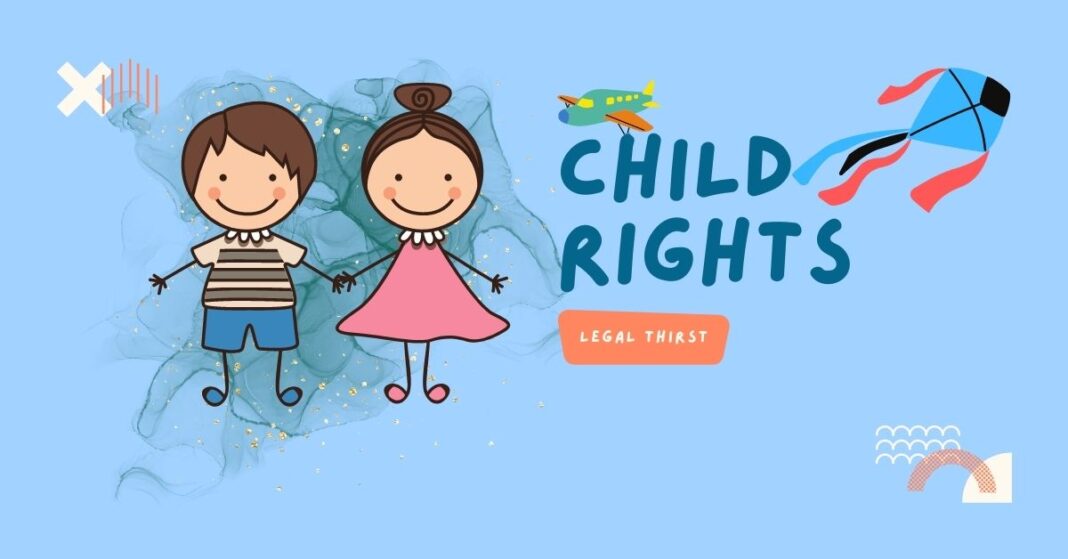Table of Contents
INTRODUCTION-
When it comes to LEGAL RIGHTS, we keep adults and children on the same pedestal. Approximately 29% of the world population comprises children, let alone 41% in India. Firstly, getting down to fathoming what does a child means? According to UNCRC (the most imperative and comprehensive convention forming the basis of child rights) states “a child is any person under the age of 18”. Each child is an asset to society and it is the onus of the state to make certain that no child is held back from having access to opportunities.
It becomes extremely vital to ensure every child avail legal rights since the upcoming generation will assume responsibility and power in the future. This article aims at comprehending the nuances of this subject. Child rights are entitlements that include social, economic as well as cultural rights. Every child has a claim on these rights without being subjected to discrimination on any grounds
IN INDIAN CONSTITUTION-
The Indian constitution has not fallen behind and is upfront in striding towards ensuring entitlement to various rights. Multiple articles in the constitution have been enshrined envisaging a secure future for the youth free from any deprivation and bias. Constitution provides for mandatory elementary education for all children between the age of 6-14 under the ambit of Article 21A.
Offenses like human trafficking and forced labor are severely prohibited under Article 23. Article 24 of the constitution protects the employment of children under the age of 14 in hazardous areas like factories or mines. Protection of children is not confined to fundamental rights it extends to directive principles of state policies too. Article 39 specifically protects children from abuse and guarantees equal opportunities and development.
Not only the Indian constitution but also the Indian Penal Code sets forth certain sections which protect and recognize the rights of the children. Under Section 82 anything done by a child below the age of 7 does not constitute an offense. Under Section 83 anything done by a child between the age of 7-12 does not constitute an offense unless he has the ability to understand the nature and consequences of his actions
LEGISLATIVE PROVISIONS-
Child Marriage-
Child marriage is an age-old issue pervasive in society, especially in the backward and rural areas. The age-old tradition of marrying away children at a tender age has been a perpetual practice. Child marriage continues to be prevalent even after being outlawed under The Prohibition of Child Marriage Act, 2006 The minimum age of marriage has been set by the government which is 18 years for girls and 20 for boys. A laudatory step has been taken by the government of increasing the minimum age of marriage for girls too so that their basic rights do not get inhibited.
Child Labor-
The Child Labor (Prohibition and Regulation) act 1986, expressly prohibits the employment of children under the age of 14 in hazardous areas such as mines and factories, which deprives them of basic amenities and inhibits their right to live a dignified life. Despite being illegal, this practice is widely practiced because low-income families continue to employ children to supplement their income.
Juvenile Delinquent-
The primary goal of the aforementioned act is to act in the best interests of the child. It not only prevents crimes against children but also ensures that they are not treated unfairly. As the name implies, juvenile delinquency refers to children who are involved in any crime or illegal activity. The act ensures that the adjudication process runs smoothly. It places the burden on the state to provide care and legal assistance to those in need.
POCSO (prevention of children from sexual offenses)-
The ministry of women and child development specifically introduced the act to provide protection to children from sexual assault, harassment, pornography, penetrative/non-penetrative offenses with the help of a proper child-friendly judicial system. Police must assist the child in the investigation process and ensure the utmost protection and care.
LANDMARK CASE LAWS-
The case of Mc Mehta vs State of Tamil Nadu, 1996 dealt with a town Sivakasi in the state of Tamil Nadu where children were employed in match stick factories which were extremely hazardous. It made children vulnerable and infringed their rights to live a dignified life and went against the law which clearly proscribes employment of children in hazardous areas. Families with meager incomes employ children to augment their income levels. The court not only ordered the establishment of a welfare fund but also ensured that the employment of adults must be preferred over children when the workspace is hazardous.
In Unni Krishnan vs State of Andhra Pradesh, 1993 dealt with the charging of exorbitant capitation fees by institutions. Every child is entitled to the right to right to education under the ambit of the right to life (article 21).
INTERNATIONAL LEVEL-
UNCRC which stands for United Nations Convention of Rights of Children is an international treaty that sets out an eclectic mix of rights to children. India ratified it in 1992. Being the most ratified treaty, it acted as a catalyst in bringing out radical changes towards the protection of child rights and ensuring safeguards for the same. It comprises as many as 54 articles.
Some of the most prominent being – Article 2 places an onus on the state to ensure children are entitled to rights mentioned within the treaty without being discriminated on any grounds, Article 3-Every action taken by an institution, authority, or body must be in the best interest, etc. Other than the aforementioned rights UNCRC consists of protocols in further defending child rights. Optional Protocol on the sale of children, child prostitution, pornography, involvement of children in armed conflict, and on a communications procedure.
PRESENT SCENARIO-
If we look at the present scenario the situation continues to be bleak and dismal. Despite multiple initiatives and progressive actions, we are still grappling with issues of child labor, marriage, etc. There is a call for modifications in the current policies and the need for more sensitive programs to bring about the desired results. Despite all the measures taken the plight of children hasn’t come to an end yet and had been continued perpetually.
Children from the most vulnerable section of society always fall prey to exploitation. A major proportion of the population resides in the backward areas and are poverty-stricken which are major stumbling blocks. We have manifold provisions in the Indian constitution in the form of fundamental rights and directive principles of state policy, several legislations, acts, statutes have been framed, we have ratified treaties at the international levels too.
CONCLUSION
We have come a long way but there’s still a lot more to be done. In order to bring out radical changes, some stringent measures must be adopted. A pragmatic approach will help yield necessary results. Children constitute the most precious and vulnerable section of society. The foremost step would be to create awareness regarding the rights and then ensure entitlement to these rights. It’s saddening and rejecting to see a large chunk of children being deprived of having access to a dignified life with amenities, liberty, and freedom.
Disclaimer: The opinions and views in the articles and research papers published on this website; are personal and independent opinions of the author. The website is not responsible for them.
Legal Thirst has created a Telegram group for exchanging legal knowledge, Events, and various opportunities.
You can click on this link and join:
Follow Legal Thirst on Instagram and Subscribe to our YouTube channel for more amazing legal content.
Legal Thirst has created a telegram group for exchanging legal knowledge, Events, and various opportunities.
You can click on this link and join:
Follow Legal Thirst on Instagram and Subscribe to our YouTube channel for more amazing legal content.



